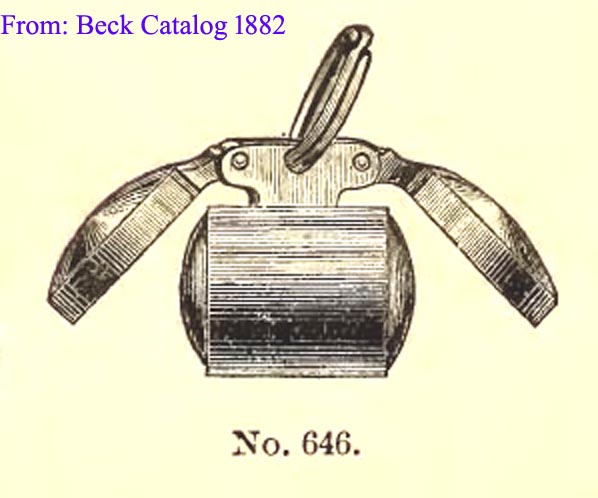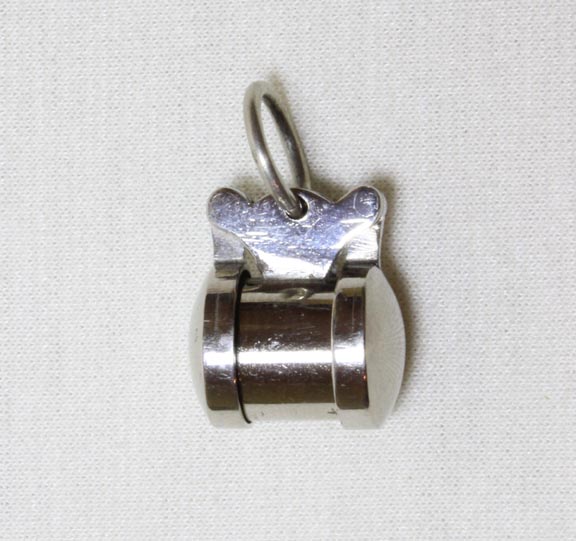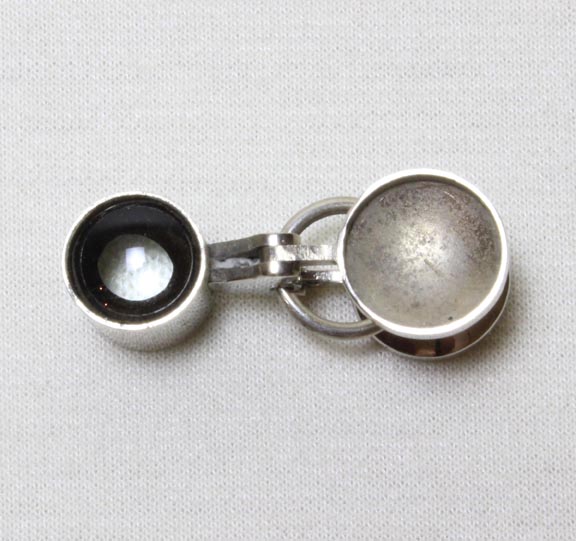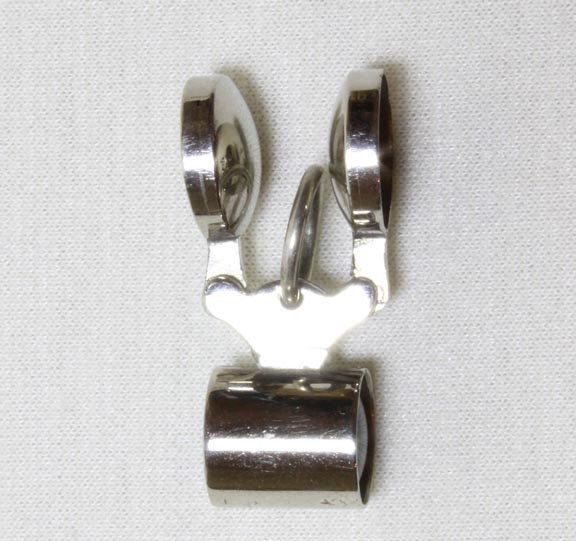HANDHELD SMALL CODINGTON MAGNIFIER
YEAR: c. 1930
UNSIGNED
ORIGIN: Possibly English
DESCRIPTION:
This tiny rhodium- or chrome-plated magnifier is about 17 mm (0.7 inches) wide. The optical element measures about 10mm (0.4 inches) in diameter, but the optical opening is only about 5 mm (0.2 inches) in diameter. The center of the instrument has a loop for hanging from a chain. Each end has a hinged cover to protect it.
 This tiny instrument was a design sold for many years. Similar instruments are shown in the Beck catalog of 1882 and in the Queen cat from 1890. In the Beck catalog it was offered in brass, German silver, solid silver, and even Gilded. This example is likely later, being either rhodium or chrome plated, circa 1930 or even later, as chrome plating was first developed in the 1920's and popularized in the mid 1930's. Rhodium plating was also first used in the 1930's. The two are very similar in appearance.
This tiny instrument was a design sold for many years. Similar instruments are shown in the Beck catalog of 1882 and in the Queen cat from 1890. In the Beck catalog it was offered in brass, German silver, solid silver, and even Gilded. This example is likely later, being either rhodium or chrome plated, circa 1930 or even later, as chrome plating was first developed in the 1920's and popularized in the mid 1930's. Rhodium plating was also first used in the 1930's. The two are very similar in appearance.
HISTORY OF THE CODDINGTON MICROSCOPE
Until and even after the invention of the achromatic aplanatic microscope, small
pocket-sized magnifiers were in great demand. A simple uncorrected lens worked
well enough for very low powers, but once magnification exceeded just a few X,
distortions became apparent. These include spherical aberration, chromatic
aberration, and curvature of the field of view. Several different methods were
used to minimize these distortions, the most major one being spherical
aberation. The simplest and easiest, was simply to 'stop-down' the aperture
with a diaphragm. This was common in compound microscopes until the widespread
use of achromatic aplanatic objectives. In 1812 William Hyde Wollaston
introduced a much improved version of the earliest magnifiers
employing two hemispheres of glass mounted together with a small stop between
them. Sir David Brewster improved the design by using a single piece of glass
and cutting deep groove in it. In 1829, Henry Coddington popularized the
Wollaston-Brewster lens, and further refined the design by modifying the shape
of the groove, though Coddington never claimed to be its inventor. It was much
less expensive than creating a complex lens from different elements and then
cementing them together. The Coddington lens was sold in various sizes and
types from its inception, right into the 21st century; it is still available
today and is an inexpensive alternative to more complex magnifiers. It allows a
magnification of up to 20 diameters, whereas an ordinary magnifier is limited to
less than 5. Its major drawback is the reduced size of the field of view.
Despite the latter drawback it is far superior to the simpler Stanhope type of
magnifier. Improvements above this design generally are multi-element
magnifiers which increase the field of view and flatten the image across that
field. The design of this magnifier was apparently used for half a century, noting the 1882 catalog entries and the likely circa 1930 date of this rhodium or chrome-plated example. Rhodium plating ceased being used commercially at the beginning of WWII.



 This tiny instrument was a design sold for many years. Similar instruments are shown in the Beck catalog of 1882 and in the Queen cat from 1890. In the Beck catalog it was offered in brass, German silver, solid silver, and even Gilded. This example is likely later, being either rhodium or chrome plated, circa 1930 or even later, as chrome plating was first developed in the 1920's and popularized in the mid 1930's. Rhodium plating was also first used in the 1930's. The two are very similar in appearance.
This tiny instrument was a design sold for many years. Similar instruments are shown in the Beck catalog of 1882 and in the Queen cat from 1890. In the Beck catalog it was offered in brass, German silver, solid silver, and even Gilded. This example is likely later, being either rhodium or chrome plated, circa 1930 or even later, as chrome plating was first developed in the 1920's and popularized in the mid 1930's. Rhodium plating was also first used in the 1930's. The two are very similar in appearance.